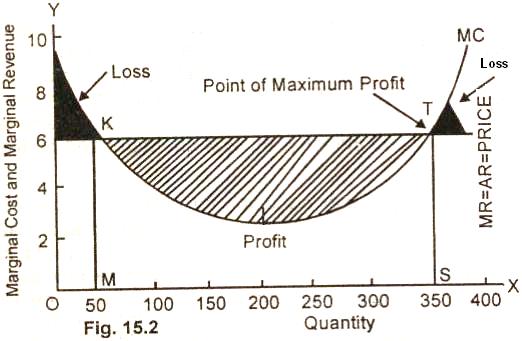Equilibrium of the Firm
Under Perfect Competition
or
Marginal Revenue = Marginal Cost (MR = MC) Rule:
Definition and Explanation:
A firm under
perfect
competition faces an infinitely elastic demand curve or we
can say for an individual firm, the price of the commodity is
given in the market. The firm while making changes in the
amounts of variable factor evaluates the extra cost incurred on
producing extra unit MC (Marginal
Cost).
It also examines the change in total receipts which
results from the sale of extra unit of production MR (Marginal
Revenue). So long as the additional revenue from the sale of
an extra unit of product (MR) is greater than the additional
cost (MC) which a firm has to incur on its production, it will
be in the interest of the firm to increase production.
In economic terminology, we can say,
a firm will go on expanding its output so long as the marginal
revenue of any unit is greater than its marginal cost. As
production increases, marginal cost begins to increase after a
certain point. When both marginal revenue and marginal cost are
equal, the firm is in equilibrium. The firm at this equilibrium
point is cither ensuring maximum profit or minimizing losses.
This is shown with the help of a diagram below:
Diagram/Figure:

In the figure (15.2) quantity of
output is measured along OX axis and marginal cost and marginal
revenue on OY axis. The marginal cost curve cuts the marginal
revenue curve at two points K and T.
The competitive firm is in
equilibrium, at both these points as marginal cost equals
marginal revenue. The firm will not produce OM quantity of good
because for OM output, the marginal cost is higher than marginal
revenue. Marginal cost curve cuts the marginal revenue curve
from above. The firm incurs loss equal to the black shaded area
for producing 50 units (OM) of output.
As production is increased from 50
units to 350 units (from OM to OS) marginal cost decreases at
early levels of output and then increases thereafter. The
marginal cost curve cuts the marginal revenue curve from below
at point T. The shaded portion between M to S level of output
shows profit on production. When a firm produces OS quantity of
output; it earns maximum profit. The point T where MR = MC is
the point of maximum profit.
In case, the firm increases the
level of output from OS, the additional output adds less to Its
revenue than to its cost. The firm undergoes losses as is shown
in the shaded area.
Summing up, profit
maximization normally occurs at the rate of output at which
marginal revenue equals marginal cost. This golden rule holds
good for all market structures. As regards the absolute profits
and losses of the firm, they depend upon the relation between
average cost and
average revenue
of the firm.
Relevant Articles:
|